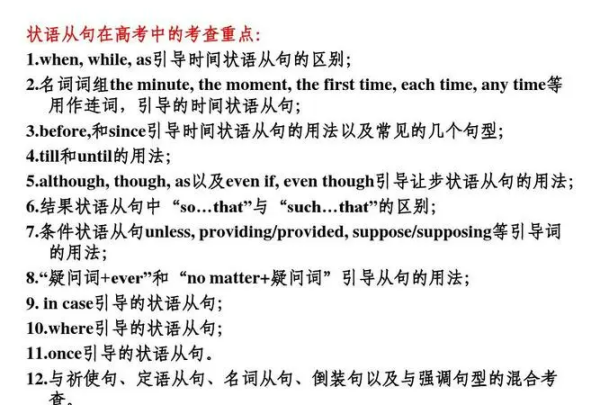本文目录
地点状语从句例句10句
地点状语从句例句如下:
1、We must camp where we can get water.我们必须在能找到水的地方露营。

2、Go back where you came from.(where引导地点状语从句)你从何处来到何处去。
3、Go back to the village where you came.(where引导定语从句,修饰village)回到你来的那个村子里去。
4、you can go where you want to go .你可以去你想去的地方。
5、With a car,a person can go where he pleases and when he pleases.有了汽车,人可以想去哪儿就去哪儿,想什么时候去就什么时候去。
实用阶梯英语语法教程第三版答案状语从句
基础英语语法:状语从句
在年少学习的日子里,大家都背过不少知识点,肯定对知识点非常熟悉吧!知识点就是掌握某个问题/知识的学习要点。那么,都有哪些知识点呢?下面是我为大家收集的基础英语语法:状语从句,欢迎大家借鉴与参考,希望对大家有所帮助。

时间状语从句
1、when的用法
(1)when既可引导一个持续性动作,也可引导一个短暂性动作,可用于表示主句和从句动作同时发生或从句动作先于主句动作,有时还可表示从句动作后于主句,意为“当……时候”。
(2)when在be about to do……when……,be doing……when……,had done……when……,be on one’s way……when……,be on the point of doing……when……等结构中,作“那时突然”讲。
(3)when “既然、鉴于;尽管,虽然(位于主句之后);如果”
2、while的用法
(1)表示“当……时候”,引导的动作必须是延续性的。
(2)用作并列连词,表示相对关系“然而”。
(3)引导让步状语从句,相当于although,意为“虽然”,位于主句前。
(4)引导条件状语从句,相当于as/so long as,意为“只要”。
3、as 的用法
(1)表示“当……时候”,强调同时发生,不指先后。
(2)说明两种正在发展或变化的情况,表示“随着”,表示时间的推移。
(3)表示“一边……一边……”。
(4)强调两个动作紧接着发生。
(5)表示“虽然,尽管”。
(6)其他含义“正如,正像”,“作为”,“由于,因为”。
4、before的用法
(1)一般意为“在……之前”“……才”,“……就”“还没有……”“免得”“不知不觉”“宁可,宁愿”,“否则,要不然”。
(2)It + will be/was + 时间段+before+一般现在时/一般过去时。在肯定句中,意为“多长时间之后才”;在否定句中,意为“用不了多长时间就”。
5、until和till
(1)与肯定句连用,必须是延续性动词。
(2)与否定句连用,必须是非延续性动词,表示“直到……才,在……之前不……”。
注意:not until可用于强调句和倒装句
强调句:It is/was not until…that…倒装句:not until 放句首时,主句要部分倒装。
6、since的用法
(1)since后是非延续性动词,时间起点从该动作发生算起,意为“做某事多久了”;since后是延续性动词,时间起点从该动作结束算起,意为“不做某事已有多长时间”。
(2)It is/has been +时间段+since+一般过去时
7、表示“一......就......”的句型
(1)as soon as, once,immediately,directly,instantly,the moment,the minute等引导的从句都表示从句的动作一发生,主句的动作随即发生,常译作“一……就……”,这类从句中,经常用一般现在时态代替将来时态。
(2)on doing sth.或“on one’s+名词”作时间状语。
8、有些名词和副词可以起连接词的作用,引导时间状语从句。
注意:时间状语从句中不用将来时态。若要表示将来时间,可用一般现在时态表示。但when引导名词性从句时,从句中要使用将来时。
地点状语从句
1、地点状语从句由where,wherever引导。
注意:where与where的`区别:Where表特定的地点,而wherever表示非特定的地点。
Wherever=to/at any place where
2、地点状语从句与定语从句的区别
Where引导定语从句时,从句前应有一个表示地点的名词作先行词;而状语从句前则无先行词。
原因状语从句
引导词:because, since,as, now that, not that…, but that…, seeing that, considering that, in that
注意:for也可以表示原因,属并列连词,但不是说明直接原因,而是对某种情况加以推断,用于表示补充说明理由。
目的状语从句
引导词:so, so that, in order that, that, to the end that(以便,为了),in case,for fear that,lest(以免,以防),
目的状语从句中通常有情态动词can,could,may,might,should,would等。
注意:1、in case 还可表示“万一,假如”。
2、目的状语从句可以用so as to, in order to 等不定式代替,但主句和从句的主语必须一致。
结果状语从句
引导词:so...that(如此……以至于……),such...that(如此……以至于……),so that(结果是),with the result that(所以,结果是)
注意: (1)so...that与such...that的区别
So+形容词such+a/an+形容词+单数名词
So+形容词+a/an+单数名词such+形容词+复数名词
So+副词such+形容词+不可数名词
So many/few+复数名词
So much/little+不可数名词
(2)so that引导的目的状语从句与so that 引导的结果状语从句
目的状语从句一般使用情态动词,结果状语从句一般不使用情态动词;
结果状语从句常常用逗号与主句分开。
(3)so...that与so...as;such...that与such...as
So...that/such...that为结果状语从句;so...as/such...as为定语从句。
条件状语从句
引导词:if(如果),unless(除非),if only(只要,但愿),only if(只有),in case(万一),suppose/supposing(that)
(假设),provided/providing(that)(只要,假若),on condition that(要是,在……条件下),so/as long as(只要),(let's/let us)say(假设)
方式状语从句
引导词:as(像……一样,正如……),as if/as though(好像,宛如)
注意:1、固定句型A is to B what C is to D.意为“A对B而言正如C对D一样”。
2、as if, as though引导的从句若与事实相反,用虚拟语气;若与事实相符,不用虚拟语气。
让步状语从句
引导词:though/although/as(虽然,尽管),even if/though(即使,尽管),whether/no matter whether...or(not)
(不管……是否,不管是……还是)wh-ever/no matter wh-(无论……)
注意:(1)though,although,as的区别
A、Though,although的主句中可以用yet, still, nevertheless,但不可使用but。
B、though引导的从句可以倒装,也可以不倒装;as引导的从句必须倒装;although引导的从句不能倒装。
其结构为:形容词/分词/副词/动词原形/名词(无冠词)+as/though+主语+谓语……
(2)though可用作副词,放在句末,意为“不过,但是”。Although无此用法。
(3)某些短语也引导让步的从句或短语,意为“尽管”,如:in spite of the fact that, despite the fact that, regardless of(the fact that)
比较状语从句
引导词:as...as(和……一样),not as/so...as(和……不一样),than(比),the more...the more...(越……越……)
状语从句中的省略问题
1、在状语从句中如果主语与主句的主语一致,同时从句中又含有系动词be,则通常可省去从句的主语和系动词be,留下其余部分。
2、若状语从句中主语是it, 动词是系动词be, 则通常可省去主语it及系动词be,留下其余部分。
实用语法总结之状语从句
状语从句有时间、地点、原因、目的、方式、结果、条件、让步等八种。
一、时间状语从句
引导词有after,before,as,once,since,till,until,when,whenever,while,as soon as,the moment/minute…(一…就),the time,the day,every time,next time,each time,by the time of,no sooner…than(一…就),hardly…when(一…就)。例如:
Each/Every time he comes here,he will drop in on me.
每次他来这儿他都顺便看我。
He was ill last time I saw him.上次我见到他时他病了。
No sooner had she heard the news than she cried.她一听到这个消息就哭了.
【辨析】when与while
when引导的从句动词可以是延续性的或短暂性的,while引导的从句中动词必须是延续性的;在"be…when…”句式中when表"at that time(就在这时)"意,这样用的when不能换为while;while有时并不表示时间,而表示对比,意“而”、“却”,when无这样的用法。例如:When I got home I found the door locked./While(或When)we were working in the fields,it suddenly began to rain./He was wandering through the streets when a bike hit him./His pencil is red,while mine is yellow.
【辨析】till与until
一般情况下可以互换,但until可以位于句首,till则不能。例如:
Until it stops raining,the children can?t go out.雨停了,孩子们才能出去.
=Not until the rain stops can the children go out.
二、地点状语从句
引导词有where,wherever.例如:
I?ll go wherever the people want me to go.(wherever=to any place where)
He works where his grandfather fought.(where=in the place where)
Where there is a will,there is a way.(Where=In the place where)
三、原因状语从句
引导词有because,since,as,now(that)(既然)
回答以why提出的问题时,只能用because,而不能用as等。
since=now(that),表“既然”意,表示已知的或明显的原因,由此加以推论。例如:
Now that/Since you are free today,you may have a rest at home or go out for a walk.
for 是一个并列连词,用来连接两个并列句,引导的句子是对前面一句话的内容的推测或补充说明。例如:It must have rained last night,for the ground is wet./The day has broken,for the birds are singing.(这两句中的for都不可换为because或as,since等。)
四、目的状语
引导词有so that,in order that,that ,incase(免得,以防)。目的状语从句谓语常含有can/could/may/might/will/would等情态动词。例如:
He ran as fast as possible in order that he could catch the bus./Please remind me of it again tomorrow in case I forget.请明天再提醒我一下,以免我忘记。
五、方式(或比较)状语从句
引导词有as,as if,as though,than,as/so…as,the more…the more.例如:
Tom is not so/as tall as John./It looks as if it is going to rain./He runs faster than I.
注:as…as既可用于肯定句,又可用于否定句,so…as只能用于否定句。
六、结果状语从句
引导词有so…that,such…that,so that.例如:
1. He works so hard that he makes great progress in his studies.
2. It?s such a difficult problem that nobody can work it out.
3. There?s not any noise here so that I feel very comfortable.
第3个例句中so that从句不是目的状语从句,从结构上看没有can,may等情态动词,从意思上看I feel very comfortalbe是There is not any noise的结果.
七、条件状语从句
引导词有if,unless,as/so long as,on condition that,in case(如果)等,从句的时态用一般现在时(含现在完成时),一般过去时(含过去完成时)分别代替一般将来时和过去将来时。例如:
If it rains tomorrow,I won?t go there./He said he would not go back home unless he had achieved a lot./I?ll study so long as. I?m alive./In case he come,let me know.如果他来的话,告诉我一声。
If 引导的条件句可以是真实性条件句,也可以是非真实性条件句、(用于虚拟语气)
八、让步状语从句
引导词有though,although,even if,even though,as,whoever,whatever,
however,no matter+what/who/when/…等。例如:
Though/Although he is ill,he still goes to school./She started her experiment,even though she had little money./Whatever you found,you must turn it in./However hard he worked,he hardly made any progress.
as 作“尽管”意时,一般将其句中的表语放在句首,例如:Young as he is,he knows a lot.=Although he is young,he knows a lot.若表语为名词,冠词要省略,例如:
Child as/though he is,he has remembered a lot of English words.(此句中though不可换为although)
although或though不能与but同时出现在一个复合句中,但是"Although/Though…,(and)yet…”句式却是正确的。例如:
Although it is raining heavily,yet they are repairing the bridge.
;状语从句例句100句
1、I will call you as soon as I arrive in Beijing
译文: 我到北京就将给你打电话。
2、As soon as I have finished this work, I will have gone home
译文:我一完成此工作,就回家。
3、If he comes back, please let me know
译文:如果他回来了,请通知我。

4、wherever you go, you should work hard
译文: 无论你走到哪里,你都应该努力工作。
5、Where there is no rain,farming is difficult or impossible
译文:在没有雨的地方,耕作是困难的或不可能的。
where地点状语从句例句10句
例句:
1、I didn’t realize how special my mother was until I became an adult.
直到我成为了一个成年人我才意识到我的母亲是多么的特殊。
2、While John was watching TV, his wife was cooking.
当约翰看电视时,他的妻子正在做饭。
3、The children ran away from the orchard(果园), the moment they saw the guard.
孩子们一看到守卫就逃出了果园。
4、No sooner had I arrived home than it began to rain.
我一到家就开始下雨了。
5、Every time I listen to your advice, I get into trouble.
每当我听取你的建议时,我就会惹上麻烦。

资料:
状语从句 (Adverbial Clause) 是指句子用作状语时,起副词作用的句子。状语从句中的从句可以修饰谓语、非谓语动词、定语、状语或整个句子。
状语从句 根据其作用可分为时间、地点、原因、条件、目的、结果、让步、方式和比较等从句。状语从句一般由连词(从属连词)引导,也可以由词组引起。从句位于句首或句中时通常用逗号与主句隔开,位于句尾时可以不用逗号隔开。
以上就是关于9大状语从句例句 ,地点状语从句例句10句的全部内容,以及9大状语从句例句 的相关内容,希望能够帮到您。
